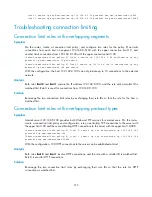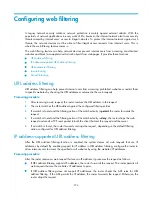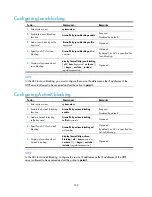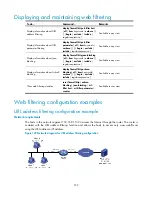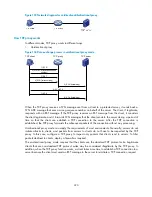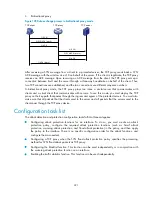
386
Configuring attack detection and protection
Attack detection and protection is an important network security feature. It can determine whether
received packets are attack packets according to the packet contents and behaviors. If it detects an
attack, it can take measures to deal with the attack, such as recording alarm logs, dropping packets,
and blacklisting the source IP address.
The attack protection function can detect three types of network attacks: single-packet attacks, scanning
attacks, and flood attacks. In addition, this function also supports traffic statistics for session analysis on
interfaces.
Types of network attacks the device can defend against
The device can defend against three types of network attacks: single-packet attacks, scanning attacks,
and flood attacks, according to the attack characteristics.
Single-packet attack
Single-packet attack is also called "malformed packet attack" because many single-packet attacks use
defective IP packets, such as overlapping IP fragments and packets with illegal TCP flags.
A single-packet attack occurs when:
•
An attacker sends defective IP packets to a target, causing the target system to malfunction or
crash.
•
An attacker sends large quantities of junk packets to the network, using up the network bandwidth.
lists the single-packet attacks that can be prevented by the device,
Table 13
Types of single-packet attacks
Single-
packet
attack
Description
Fraggle
An attacker sends large amounts of UDP echo requests with the UDP port number being 7 or
Chargen packets with the UDP port number being 19, resulting in a large quantity of junk
replies and finally exhausting the bandwidth of the target network.
ICMP
Redirect
An attacker sends ICMP redirect messages to a user host to modify the host's routing table,
interfering with the normal forwarding of IP packets.
ICMP
Unreachable
Upon receiving an ICMP unreachable response, some systems conclude that the destination
is unreachable and drop all subsequent packets destined for the destination. By sending
ICMP unreachable packets, an attacker can cut off the connection between the target host
and the network.
Land
An attacker sends a great number of TCP SYN packets with both the source and destination
IP addresses being the IP address of the target, exhausting the half-open connection
resources of the target and thereby making the target unable to provide services normally.
Large ICMP
For some hosts and devices, large ICMP packets cause memory allocation error and thus
crash down the protocol stack. A large ICMP attacker sends large ICMP packets to a target
to make it crash down.


